
Arshak Fetvadjian
#1

Posted 12 June 2004 - 04:20 PM
#2

Posted 13 June 2004 - 01:00 PM
Thank you.
If we could only view more of his over 2000 works!!!
Those pictures of Ani must be invaluable as none of those ruins are the same, and many are totally gone.
Btw. That painting of horses is known as "Post@ Sarerum", i.e. "mail at the hills", a pony express of sorts.
#3

Posted 14 June 2004 - 05:42 AM
I wonder how many of his 2000 works still survive? And what they were of. What's on the page is only a couple of dozen examples, mostly from old postcards (what would we do without ebay
Actually, I'd have prefered his paintings of Ani and other places to have been either more naturalistic or less naturalistic. The ones I have seen are not quite detailed enough to truly represent the buildings, yet they are too accurate to be individualistic or to captivate the viewers imagination. And there are never any people in them. But it might be that most of those I've shown were painted specially to be used as postcards, so were not meant to be artistically adventurous.
And they are valuable in that they show the buildings in their natural colours, unlike all the old black and white photographs.
I'd welcome any additional information about Fetvadjian that isn't on the webpage. Where was he born, for example? And what is contained in the book he published about Ani?
#4

Posted 15 June 2004 - 08:06 AM
Elementary education at schools in Trabzon, and at the Institute of Art in Constantinoplewhere he was the first to graduate(1887). During 1887-1891 he studied at the Academy of Fine Arts in Rome under inxtructors the likes of Cesare Maccari. In 1891 his works were displayed at the Italian Artists' exposition. He lived and studied in Vienna during 1891-1895, he moved to Petersburg where he was inducted into the Russian Painters' Association.
He travelled throughout Armenia, both East and West and painted ancient monuments producing more than 2000 works of pancil studies and water color. His works were displayed in the majoe cities of the time including Batum, Tiflis, Baku. During 1919 and 1920 following exhibition of his works in Paris he was inducted into the International Association of Painters in London (1921). During his 25 year stay in the United States he produced and exhibited his works at Harvard, Columbia, University of Chicago and Princeton.
Beside his works on ancient monuments he also collaborated with publishers and writers contributing his interpretations of Armenian national personnages and mythological fugures. He published commentaries and reviews about Armenian iconography and other art forms. His interests included Armenian architecture as well as national folk costumes. Among his most memorable works are Oriental Mail(Arevelyan Post, see Steve's first post), Sasuntsi Kin@ ***, Manuk Hayastan etc. In addition to a multidisciplinary genre he was also involved in decorating and designing of churches and cathedrals be they interior or exterior. His frescoe murals of St. Gevorg of Tiflis, the design of the gate of St. Grigor of Kars are the most memorable.
After his death in Medford, Mass. his remains were moved to Yerevan and his works, according to his wishes were bequethed to the National Gallery of Armenia.
*** Sasuntsi Kin@ (the Woman of Sasun) is a water color of a handsome woman perched on top of a rocky ledge obviously watching out for hostile activity. She is partially prostrate, holding a rifle in her right hand and nursing her baby at an ample bosom.
Note; We know that "fetva/fatwa" is an Arabic word meaning "sentence/judgemant" which presently is usually used to mean a sentence of condemnation or "death sentence" if you will. Remember all the fatwas issued by the mullahs of Iran, most notably against Salman Rushdi. Why did Arshak have such a surname meaning "despenser of judgements"? Was there a judgeship in his anecestry? Oh! In case you wonder what he looked like see Boghos Nubar's portrait, moustache and all. It is a shame that we cannot see his works on the internet.
#5

Posted 15 June 2004 - 08:58 AM
I had thought that he had been born in Trabzon, but then I wondered if I was mixing him up with Toros Toramanian, who I think was also born there (or was it Samsun??).
The "the design of the gate of St. Grigor of Kars" that he worked on - what do you think this could be? Is it perhaps a reference to the two big wooden doors of the Armenian cathedral in Kars, that are now in the Kars museum. This church, whose name I don't actually know, was used as a cinema for many years before being demolished in the early 1970s. Luckily the doors were preserved. I'll post a picture of them later.
Steve
#6

Posted 15 June 2004 - 02:30 PM
See his portrait here; He is the moustachioed (Raffi Hovanisian lookalike
http://www.virtualan.../marr/index.htm
He was born in Shabin Karahisar ** Sept 18, 1864, died in Yerevan, March 1, 1934.
After elementary education at local Armenian school he studied at the Constantinople Academy of Fine Arts (1888-1893) where he interned as an architectural draftsman. In the wake of the massacres of 1895, aka Mets Yeghern/Big Massacre he moved to Bulgaria where his drafts were used to design many buildings both architectural and commercial. I 1900 he moved to Romania and to Paris in 1902 wher he furthered his studies in the science of architecture. To get more intimately acquaineted with classical architecture he spent time studying in Rgypt, Greece and Rome. In 1903, in the company of Karapet Basmajian (another scholar/pharmacist/physician/philologist in his own right), he first visited Ani with the intention of compiling of an album of the architecture and antiquity of the site. He was saddened to discover that this jewel of medieval architecture was all but totally unknown to the so called civilized world, even to the Armenian intelligentsia. (Of course, this was all before Ani was demarcated into the map of Turkey. The son of bitches, whose definition of architecture is destruction v construction. Strike that!
He traveled extensively within the new country, and during thos 30 years he studied, recorded, photographed and planned rehabilitation of hundreds of sites.
It was because of Toros Toramanian that Armenian archeology and architecture gained a unique place in Erope and the world. He was buried at the Memorial Park named for Komitas.
** Shabin Karahisar, a town in the Trabzon region, equally famed for giving us another favorite son, General Andranik Ozanian, fondly known as Zoravar Andranik. The present name, Turkish for Black Fortress is a direct translation of its traditional Armenian name of Sevaberd (Greek; Maurocastron).You may learn more about it, in particular the Battle of Shabin Karahisar by a simple search.
#7

Posted 15 June 2004 - 04:42 PM
Attached Files
#8

Posted 15 June 2004 - 04:50 PM
Attached Files
#9

Posted 15 June 2004 - 04:52 PM
Attached Files
#10

Posted 15 June 2004 - 04:54 PM
Attached Files
#11

Posted 15 June 2004 - 04:57 PM
Attached Files
#12

Posted 15 June 2004 - 04:59 PM
Attached Files
#13

Posted 15 June 2004 - 05:00 PM
Attached Files
#14

Posted 15 June 2004 - 08:56 PM
This door of mine is in the memory of Gayane Melqonian Pinachiants
#15

Posted 16 June 2004 - 10:49 AM
I know the locations of the first two. So the destroyed church, the church where the doors came from, MUST be St. Grigor. And so these doors ARE the ones designed by Fetvadjian. I don't kno if this is a new discovery / rediscovery though
#16

Posted 20 June 2004 - 03:10 PM
See his portrait here; He is the moustachioed (Raffi Hovanisian lookalike
Here is that portrait by Saryan.
http://www.antares.a...picture2-16.htm
Edited by Arpa, 20 June 2004 - 03:12 PM.
#17

Posted 17 March 2013 - 08:07 AM
See the full text below;
http://www.virtualan...photograph1.jpg
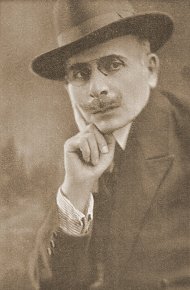
http://www.virtualan...photograph2.jpg
See his biography and his works here. Thank you Steve of Virtual Ani;
http://www.virtualan...djian/index.htm
http://www.virtualan...hedral_1905.jpg
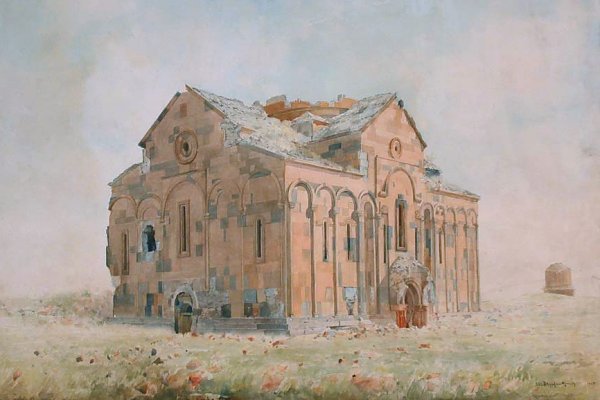
=====
Book helps revive interest in Arshag Fetvadjian's art
by Lucine Kasbarian
Published: Thursday March 14, 2013
Cover of Levon Chookaszian's book about Fetvadjian.
Related Articles
Lucy Der Manuelian: A pioneer in the study of Armenian architecture
Belmont, Mass. - He documented monumental, now-vanished Armenian architecture. He painted representations of our women in folkloric dress. His reproductions launched public awareness of Armenian manuscript illumination. He illustrated the creativity of Armenian ornamental inscription and sculpture. And he designed the currency and postage stamps of the First Republic of Armenia in a way that celebrated our artistry and traditions.
The man was Arshag Fetvadjian (1866-1947), and through the meticulous research of eminent Armenian art historian Levon Chookaszian, the global Armenian community and art lovers alike have been given the opportunity to rediscover a true son of the Armenian nation whose love of homeland highlighted nearly all of his accomplishments as a leading Armenian artist and art historian of the 19th century.
Chookaszian, founder and director of the UNESCO Chair of Armenian Art History at Yerevan State University, has embarked on a lecture tour to celebrate Fetvadjian and the release of Chookaszian's book about the art legend. ("Arshag Fetvadjian," in English, Armenian and Russian, $75, Yerevan, Armenia: Printinfo, 2011.) In an intimate, engaging and inspiring multi-media lecture, Chookaszian did justice to the many facets of Fetvadjian the man and the diversity of his artistic aptitudes.
This event was held on November 7 at the National Association of Armenian Studies and Research's (NAASR) in conjunction with an exhibition of Fetvadjian's work at the Armenian Library and Museum of America (ALMA), a co-sponsor of this event.
Born in the Black Sea region of Trebizond, Fetvadjian, at age 16, enrolled at the Imperial School of Fine Arts in Constantinople. Graduating with high honors, he was awarded the school's "Rome Prize," which would allow him to study in Italy with the proviso that he return to Turkey and accept a state position. As Chookaszian explained, Fetvadjian turned down this prize on the recommendation of a trusted advisor, Voskan Bey Mardikian.
Under the veil of anonymity, Mardikian bequeathed a sum for Fetvadjian to pursue his art studies in Rome but advised him to never return to Turkey. Instead, he urged Fetvadjian to go forth into the world and promote the unsung greatness of a beleaguered Armenia through his art.
While in Italy, Fetvadjian "became inspired by the heroic spirit of the Italians who were freed from Austrian control," wrote Chookaszian in his book. "That inspiration was essential for the formation of artistic and political views of Fetvadjian."
As was evident from the body of work he left behind, Fetvadjian was an ardent defender of "hayabahbanoum," or preservation of the Armenian identity. "It was as if a voice from within was telling him to mark out our national treasures on the ground," said Chookaszian. And this was with good reason, he continued, "as many if not most treasures did not withstand the depredations of the Genocide, nor was the Western world aware of them."
Fetvadjian's many illustrious colleagues included the father of Armenian architectural historiography, Toros Toramanian, with whom Fetvadjian studied the remains of medieval Armenian architectural monuments, particularly at Ani, the famed Armenian city of 1,001 churches. Among Fetvadjian's best-known paintings is "Woman of Sassoun," a rifle-clad matron defending the Armenian highlands from the Turkish onslaughts while suckling a child said to metaphorically represent Armenia. Many elder Armenian-Americans will recall when Fetvadjian was commissioned to create his magnificent painting of a very Armenian-looking "Madonna and Child" that still graces the altar of St. Illuminator's Armenian Cathedral in NYC. All in all, Chookaszian's presentation made abundantly clear that Fetvadjian is to be venerated for documenting and popularizing many aspects of our ancient culture and customs through his works.
Even though Fetvadjian has been honored with two large exhibitions in Yerevan, in the 1950s he was all but forgotten by the Soviet Armenian authorities, and by extension, the natives of the land. Fetvadjian was undoubtedly neglected in the Soviet era because of the patriotic nature of his work and his close association with the first Republic of Armenia. Had Fetvadjian's works been made available during Soviet times, asserted Chookaszian, his paintings, research, reviews and documentation would have been able to influence and inform generations of multi-disciplinary scholars, artists and others, not only in Armenia but the world over.
After studying and creating art around the world, Fetvadjian came to NYC to pursue his profession while living under spartan conditions. Weary, depressed and longing for his native land, he was urged by Manuel Der Manuelian, one of the four consuls of the first Republic of Armenia, to immigrate to Boston, where he lived for the last 25 years of his life. Manuel's offspring, Vigen, Haig and Lucy Der Manuelian, were all deeply affected by Fetvadjian's presence as an adoptive member of their family. This is greatly evidenced by the accomplishments of all three children: Vigen and Haig pledged to open a museum as a tribute to all that they had come to love about Armenia and its people, resulting in their establishment of ALMA. And Lucy became a prominent historian of Armenian art and architecture in her own right.
Just as the government of Soviet Armenia in 1947 extended an invitation for Fetvadjian to return and live in Armenia, he passed away in Massachusetts, but not before packing up his life's work to bequeath to the National Gallery of Armenia for safeguarding and exposition. It was Levon Chookaszian's grandfather's cousin, Barkev Chookaszian, who led the drive to return Fetvadjian's art, archive and human remains to Armenia.
While master artists such as Vartkes Sureniants and Krikor Khanjian are roundly celebrated for capturing the imagination and reverence of the Armenian people, we have visionary art historians such as Chookaszian to thank for reinstalling Fetvadjian into our collective memory and into the very same pantheon of illustrious Armenian national artists.
Among their many other accomplishments, Levon Chookaszian and his brother Karekin are to be thanked for initiating the Virtual Museum of Armenian Art, a multimedia software series created to safeguard and promote the endangered world of our Armenian art heritage.
The lavishly illustrated "Arshag Fetvadjian" book is available at NAASR Bookstore in Belmont; Abril, Sardarabad and Berge Bookstores in Los Angeles; and Artbridge, Noyan Tapan, and Matenadaran Bookstores in Yerevan, among others.
#18

Posted 17 March 2013 - 08:45 AM
http://www.virtualan...djian/index.htm
Here are a few on my favorites.
Mother Ani.
http://www.virtualan...an_of_sasun.jpg
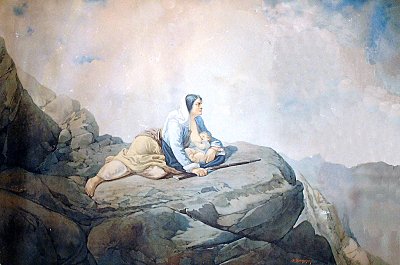
Detail.
http://www.virtualan...asun_detail.jpg
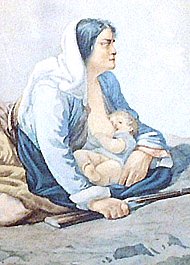
Pony Express.
http://www.virtualan...jian_horses.jpg
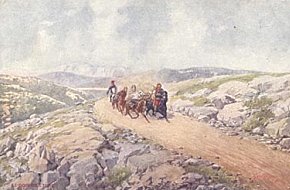
0 user(s) are reading this topic
0 members, 0 guests, 0 anonymous users















